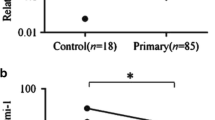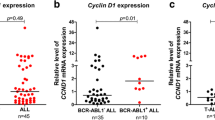Abstract
Acute lymphoblastic leukemia (ALL) is the main subtype of childhood leukemia. Risk stratification is pivotal for ALL prognosis and individualized therapy. The current factors for risk stratification include clinical and laboratory features, cytogenetic characteristics of the blast, early response to chemotherapy, and genetic factors. Analyses of gene expression are becoming increasingly important in ALL risk stratification. β-Arrestin1, a multifunctional scaffold protein mediating many intracellular signaling networks, has been shown to be involved in many tumors. However, little is known of β-arrestin1 in leukemia. In this study, we found that β-arrestin1 was significantly elevated in 155 newly diagnosed ALL patients, compared with 51 controls. Further analysis showed that β-arrestin1 expression was positively related with risk classification and white blood cell count in ALL. Moreover, expression of Notch1, an essential gene for developing hematological cells and T-ALL, was found to be negatively correlated with β-arrestin1 in ALL. In conclusion, β-arrestin1 may be a useful predictor of risk stratification and prognosis of ALL, and thus of potential use in the design of individualized therapy strategies.


Similar content being viewed by others
References
Rana ZA, Rabbani MW, Sheikh MA, Khan AA. Outcome of childhood acute lymphoblastic leukaemia after induction therapy-3 years experience at a single paediatric oncology centre. J Ayub Med Coll Abbottabad. 2009;21:150–3.
Pui CH, Robison LL, Look AT. Acute lymphoblastic leukaemia. Lancet. 2008;371:1030–43.
Heuser M, Ganser A, Hoelzer D. The hematopoietic growth factors in acute leukemia: a European perspective. Cancer Treat Res. 2011;157:339–62.
Bauters T, Mondelaers V, Robays H, De Wilde H, Benoit Y, De Moerloose B. Methemoglobinemia and hemolytic anemia after rasburicase administration in a child with leukemia. Pharm World Sci. 2010 [Epub ahead of print].
Karas Kuzelicki N, Milek M, Jazbec J, Mlinaric-Rascana I. 5,10-Methylenetetrahydrofolate reductase low activity genotypes reduce the risk of relapse-related acute lymphoblastic leukemia. Leuk Res. 2009;33:1344–8.
Rubnitz JE, Pui CH. Childhood acute lymphoblastic leukemia. Oncologist. 1997;2:374–80.
Butturini A, Arlinghaus RB Gale RP. BCR/ABL and leukemia. Leuk Res. 1996;20(5):23–9.
Mansur MB, Enmerenciano M, Splendore A, Brewer L, Hassan Rand Pombo-de-Oliveira MS. T-cell lymphoblastic leukemia in early childhood presents NOTCH1 mutations and MLL rearrangements. Leuk Res. 2010;34:483–6.
Lefkowitz RJ, Whalen EJ. Beta-arrestins: traffic cops of cell signaling. Curr Opin Cell Biol. 2004;16:162–8.
Lefkowitz RJ, Shenoy SK. Transduction of receptor signals by beta-arrestins. Science. 2005;308:512–7.
DeWire SM, Ahn S, Lefkowitz RJ, Shenoy SK. Beta-arrestins and cell signaling. Annu Rev Physiol. 2007;69:483–510.
Luttrell LM, Lefkowitz RJ. The role of beta-arrestins in the termination and transduction of G-protein-coupled receptor signals. J Cell Sci. 2002;115:455–65.
Kovacs JJ, Hara MR, Davenport CL, Kim J, Lefkowitz RJ. Arrestin development: emerging roles for beta-arrestins in developmental signaling pathways. Dev Cell. 2009;17:443–58.
Chen W, Kirkbride KC, How T, Nelson CD, Mo J, Frederick JP, et al. Beta-arrestin 2 mediates endocytosis of type III TGF-beta receptor and down-regulation of its signaling. Science. 2003;301:1394–7.
Girnita L, Shenoy SK, Sehat B, Vasilcanu R, Vaslcanu D, Girnita A, et al. Beta-arrestin and Mdm2 mediate IGF-1 receptor-stimulated ERK activation and cell cycle progression. J Biol Chem. 2007;282:11329–38.
Wang P, Gao H, Ni Y, Wang B, Wu Y, Ji L, et al. Beta-arrestin 2 functions as a G-protein-coupled receptor-activated regulator of oncoprotein Mdm2. J Biol Chem. 2003;278:6363–70.
Zou L, Yang R, Chai J, Pei G. Rapid xenograft tumor progression in beta-arrestin1 transgenic mice due to enhanced tumor angiogenesis. FASEB J. 2008;22:355–64.
Buchanan FG, Gorden DL, Matta P, Shi Q, Matrisian LM, DuBois RN. Role of beta-arrestin 1 in the metastatic progression of colorectal cancer. Proc Natl Acad Sci USA. 2006;103:1492–7.
Yue R, Kang J, Zhao C, Hu W, Tang Y, Liu X, et al. Beta-arrestin1 regulates zebrafish hematopoiesis through binding to YY1 and relieving polycomb group repression. Cell. 2009;139:535–46.
Kalderon D. Similarities between the Hedgehog and Wnt signaling pathways. Trends Cell Biol. 2002;12:523–31.
Wilson JJ, Kovall RA. Crystal structure of the CSL-Notch-Mastermind ternary complex bound to DNA. Cell. 2006;124:985–96.
Nam Y, Sliz P, Song L, Aster JC, Blacklow SC. Structural basis for cooperativity in recruitment of MAML coactivators to Notch transcription complexes. Cell. 2006;124:973–83.
Grabher C, von Boehmer H, Look AT. Notch 1 activation in the molecular pathogenesis of T-cell acute lymphoblastic leukaemia. Nat Rev Cancer. 2006;6:347–59.
Radtke F, Schweisguth F, Pear W. The Notch ‘gospel’. EMBO Rep. 2005;6:1120–5.
Weng AP, Ferrando AA, Lee W, 4th Morris JP, Silverman LB, Sanchez-lrizarrv C, et al. Activating mutations of NOTCH1 in human T cell acute lymphoblastic leukemia. Science. 2004;306:269–71.
Girard L, Hanna Z, Beaulieu N, Hoemann CD, Simard C, Kozak CA, et al. Frequent provirus insertional mutagenesis of Notch1 in thymomas of MMTVD/myc transgenic mice suggests a collaboration of c-myc and Notch1 for oncogenesis. Genes Dev. 1996;10:1930–44.
Feldman BJ, Hampton T, Cleary ML. A carboxy-terminal deletion mutant of Notch1 accelerates lymphoid oncogenesis in E2A-PBX1 transgenic mice. Blood. 2000;96:1906–13.
Beverly LJ, Capobianco AJ. Perturbation of Ikaros isoform selection by MLV integration is a cooperative event in Notch(IC)-induced T cell leukemogenesis. Cancer Cell. 2003;3:551–64.
Bennett JM, Catovsky D, Daniel MT, Flandrin G, Galton DA, Gralnick HR, et al. Proposed revised criteria for the classification of acute myeloid leukaemia. A report of the French–American–British Cooperative Group. Ann Intern Med. 1985;103:620–5.
Wolowiec D, Mekki Y, French P, Manel AM, Bertrand Y, Rimokh R, et al. Differential expression of cell proliferation regulatory proteins in B- and T-lineage acute lymphoblastic leukaemias. Br J Haematol. 1996;l95:518–23.
Smith M, Arthur D, Camitta B, Carroll AJ, Crist W, Gaynon P, et al. Uniform approach to risk classification and treatment assignment for children with acute lymphoblastic leukemia. J Clin Oncol. 1996;14:18–24.
Livak KJ, Schmittgen TD. Analysis of relative gene expression data using real-time quantitative PCR and the 2(-Delta Delta C(T)) Method. Methods. 2001;25:402–8.
Beaulieu JM, Caron MG. Beta-arrestin goes nuclear. Cell. 2005;123:755–7.
Matsubayashi J, Takanashi M, Oikawa K, Fujita K, Tanaka M, Xu M, et al. Expression of G protein-coupled receptor kinase 4 is associated with breast cancer tumourigenesis. J Pathol. 2008;216:317–27.
Nobles KN, Guan Z, Xiao K, Oas TG, Lefkowitz RJ. The active conformation of beta-arrestin1: direct evidence for the phosphate sensor in the N-domain and conformational differences in the active states of beta-arrestins1 and -2. J Biol Chem. 2007;282:21370–81.
Kang J, Shi Y, Xaing B, Qu B, Su W, Zhu M, et al. A nuclear function of beta-arrestin1 in GPCR signaling: regulation of histone acetylation and gene transcription. Cell. 2005;123:833–47.
Acknowledgments
This work was supported by grants from the National Natural Science Foundation of China (90919013, 30871103), Natural Science Foundation of Chongqing (2008BB5072, 2010BA5008), and New Century Talented Program from Ministry of Chinese Education (NCET-2008). The authors would like to express their sincere thanks to the contribution of all patients and their families in this study.
Conflict of interest
The authors have no conflicts of interest to declare.
Author information
Authors and Affiliations
Corresponding author
About this article
Cite this article
Liu, H., Long, J., Zhang, Ph. et al. Elevated β-arrestin1 expression correlated with risk stratification in acute lymphoblastic leukemia. Int J Hematol 93, 494–501 (2011). https://doi.org/10.1007/s12185-011-0824-9
Received:
Revised:
Accepted:
Published:
Issue Date:
DOI: https://doi.org/10.1007/s12185-011-0824-9




